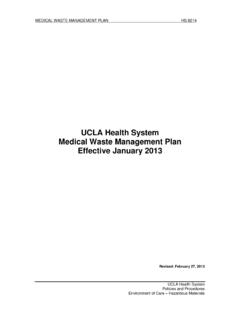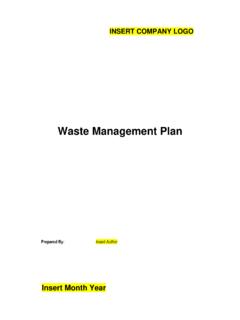Transcription of COVID-19 waste management standard operating procedure
1 Classification: Official Publications approval reference: 001559 e COVID-19 waste management standard operating procedure 18 January 2021, Version 4 Updates from Version 3, published on 23 September 2020, are highlighted in yellow. This document sets out the waste management approach for all healthcare facilities including primary care facilities and testing facilities in England. A simple and pragmatic approach will be implemented to ensure that waste is managed in a safe manner and critical waste disposal resources are not exhausted during the COVID-19 emergency response.
2 We need to work together across organisations to collectively deliver waste management services during this period of expanded demand. What does this mean for healthcare staff? You must apply the HTM 07-01 across your facilities when re-opening services for non COVID-19 patients. The COVID-19 procedure below needs to be applied for COVID-19 areas. The Advisory Committee on Dangerous Pathogens designates waste arising from COVID-19 patients as infectious clinical waste (EWC code 18-01-03*). It must be packaged in UN-approved orange bags in accordance with the safe management of healthcare waste (HTM07-01).
3 The transport categorisation for this waste is Category B. Sharps and pharmaceutically contaminated items should continue to be segregated into appropriate containers sent for incineration; these should not enter the orange bag stream. 2 | Returning to BAU in waste management while still treating COVID-19 patients: SOP In response, all healthcare settings should ensure that: All outer packaging must be removed and recycled before an item is taken onto any ward or clinical area. If this is taken into an isolation or higher risk area, then it is likely to become contaminated and therefore must be disposed as infectious clinical waste .
4 All confidential waste must be put into confidential bins. All sharps and anatomical waste must be put into the relevant receptacle with an appropriately coloured lid as per HTM07-01, and these do not need to be put into an orange bag ( In summary, infectious clinical waste should be treated like any other infectious clinical waste that is, as it would be for TB, hepatitis, etc, following national regulations. Healthcare waste is suitable for non-incineration technologies. Hospitals in addition should ensure that: All food waste must be disposed of in black bags/compostable bags.)
5 Soiled linen must be put into alginate bags and then into relevant outer bags (usually white according to local policy). Non-ambulatory patients urine and faeces to be put down the sluice/toilet. Where no sluice/toilet is available, excreta may be gelled and disposed of in an orange bag. If bed bound, urine from catheter taken to sluice/toilet. The use of these granules must be strictly controlled as described in this NHS National Patient Safety Alert; Ambulatory patients can go to the toilet as normal where safe and feasible to do so.
6 Where medicines are prepared in a clean area, pharmaceutical waste must be separated into the following receptacles: Blue non-hazardous healthcare medicines for incineration Purple waste contaminated with cytotoxic and cytostatic medicines for incineration. waste should be bagged in the appropriate colour bag. Where clinical waste carts are used, the bagged waste must be put into carts awaiting collection and disposal. Please ensure that all bins are full before releasing them from site. Disposal of all waste related to possible or confirmed cases should be classified as infectious clinical waste suitable for alternative treatment and transported as category B, unless the waste has other properties that require it to be incinerated.
7 3 | Returning to BAU in waste management while still treating COVID-19 patients: SOP No domestic waste is to be sent directly to landfill from acute hospital settings. Confidential waste generated on all wards (including isolation wards) must be disposed of via the existing confidential waste route. Confidential waste bins from areas with positive COVID-19 patients should be left for 72 hours before their contents is shredded. Primary care services waste generated in general practice or primary care dental settings from a person who has been confirmed or is suspected to have COVID-19 must be disposed of as Category B waste .
8 The transport of Category B waste is described in Health Technical Memorandum 07-01: Safe management of healthcare waste . PPE waste generated in community pharmacy and primary care optical settings from a face-to-face consultation and/or interaction with a person who has been confirmed or is suspected to have COVID-19 should be double bagged, tied securely and kept separate from other waste for at least 72 hours before being disposed of as normal domestic residual waste . All other waste should be managed as described in Health Technical Memorandum 07-01: Safe management of healthcare waste .
9 Medicines returned to a community pharmacy by a patient should be segregated as per usual requirements, double bagged and placed directly in the appropriate waste medicines container. Unwanted controlled drugs (CDs) should be double bagged and placed in the CD cabinet for three days before denaturing as per the usual pharmacy process. Community patients/clinical staff working in people s homes Where clinical staff are providing services in the home of a patient who has (or is suspected to have) COVID-19 , then PPE can be left behind in a bag.
10 This will be stored for 72 hours before being put into the person s domestic waste stream. See RPS C5: PPE waste from home healthcare workers treating patients with COVID-19 for more information. Community teams advising relatives caring for patients in their own homes are advised to follow the same guidelines. waste generated by the patient/relative will be stored for 72 hours before being put into the domestic waste stream in a standard black bag. The only waste from non-healthcare premises that should be double bagged is waste from an individual known or suspected to have COVID-19 .


















